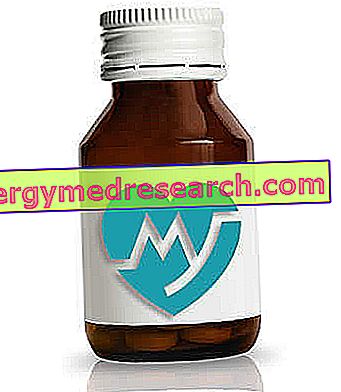LIPSIN ® is a Fenofibrate based drug (comic)
THERAPEUTIC GROUP: Ipolipemizzanti - Fibrati
IndicationsAction mechanismStudies and clinical effectiveness Usage and dosage instructionsWarnings Pregnancy and lactationInteractionsContraindicationsUndesirable effects
Indications LIPSIN ® Fenofibrate
LIPSIN ® is indicated in the treatment of dyslipidemias characterized by an excessive increase in triglycerides, when an appropriate diet and a healthy lifestyle have not produced effective results.
LIPSIN ® can also be used to treat primary hypercholesterolemia, as a statin replacement therapy.
Mechanism of action LIPSIN ® Fenofibrate
Fenofibrate taken with LIPSIN ® is absorbed at the gastro-intestinal level and hydrolysed in its pharmacologically active metabolite, fenofibric acid, which reaches its maximum plasma concentrations approximately 4 hours after the drug is taken.
The therapeutic properties of this compound are essentially due to the modulating action in the processes of synthesis / degradation of fatty acids and lipoproteins, carried out at the liver level.
More precisely, the fibrates are able to act as receptor agonists, activating the hepatic PPAR alfa receptor, modulating the expression of various genes that metabolically translates into:
- Increased synthesis of apolipoproteins ApoAI and Apo AII (protein fraction of HDL), with consequent increase in HDL cholesterolemia;
- Increased lipoprotein lipase synthesis, with increased uptake and oxidation of triglycerides contained in VLDL and LDL;
- Increased synthesis of transport proteins involved in fatty acid oxidation;
- Inhibition of the expression of ApoCIII, a protein with inhibitory action on lipoprotein lipase;
- Inhibition of the HMG-CoA reductase enzyme.
All these mechanisms are at the basis of the lipidic "normalizing" action of fenofibrate, which is realized in the reduction of plasma triglyceride and LDL cholesterol levels, and in the increase of HDL cholesterolemia.
After about 20 hours of action, fenofibric acid is predominantly eliminated through the urine.
Studies carried out and clinical efficacy
1 THE EFFICACY OF COMBINED PHENOPHIBRATE / STATINE THERAPY
More and more doctors choose to use - for the treatment of hyperlipidemia in patients with high cardiovascular risk - a combined therapy between fibrates and statins. In detail, the therapeutic action of the combination of fenofibrate and pravastatin was tested on 248 patients.
The efficacy of the combination therapy was decidedly greater, with a reduction in LDL cholesterol of 14% compared to 6% in monotherapy, in triglycerides by 22% compared to 2%, and an increase in HDL cholesterol of 6.5% compared to '1%; all in the face of the incidence of adverse events comparable between the two groups.
These results support the hypothesis of the great efficacy of combination therapy, provided a correct formulation of the therapeutic dosage.
2. PHENOFIBRATE AND COMBINED THERAPY IN THE TYPE II DIABETIC PATIENT
This important study questions the real preventive capacity against cardiovascular accidents, exerted by therapy with fenofibrate. More precisely, the researchers - while observing a significant reduction in triglyceride levels following the addition of fenofibrate in the dyslipidemic therapy of the diabetic patient - did not record a significant decrease in cardiovascular events.
The hypothesis formulated foresees a main role of HDL cholesterol in the prevention of cardiovascular events, which fenofibrate hardly succeeds in increasing.
3. PHENOPHYRATE, NOT JUST HYPOLYPHEMISATION
The therapeutic efficacy of fenofibrate observed in this study did not materialize solely in the reduction of plasma triglyceride levels (-34%) and LDL cholesterol (-20%), and in the 10% increase in HDL cholesterol, but also in a 15% reduction in fibrinogen and 13% in uric acid, thus highlighting a complex and important metabolic role of the drug.
Method of use and dosage
LIPSIN ® capsules of 200mg of comedronized fenofibrate: it is recommended to administer one capsule a day, maintaining a dietary plan and an appropriate lifestyle.
An adjustment of the dosage should be foreseen by the doctor in case of reduced renal function, in proportion to the state of health of this organ.
IN ANY CASE, BEFORE TAKING LIPSIN ® Fenofibrate - THE REQUIREMENT AND CHECK OF YOUR DOCTOR IS NECESSARY.
Warnings LIPSIN ® Fenofibrate
Before starting the drug treatment with LIPSIN ® it would be appropriate to pursue a hypolipidic diet and a healthy lifestyle for at least a quarter. In the event that this therapeutic approach proves inadequate, it is appropriate to resort to pharmacological therapy.
Before and during the administration of fenofibrate it would be useful to monitor some laboratory parameters, such as creatinine (marker of renal function) and transaminase (marker of liver function), possibly suspending the therapy following an increase in plasma levels respectively of more than 50% and 3 times the normal range.
Even after taking fibrates, it would be appropriate to investigate the possible presence of myopathies and conditions predisposing to the development of skeletal muscle diseases, constantly monitoring creatinkinase levels, in order to avoid the occurrence of rhabdomyolysis and myopathies.
It would also be appropriate to use LIPSIN ® with caution in case of peptic ulcer and in case of reduced lactose tolerance, galactosemia, lactase deficiency and glucose / galactose malabsorption syndrome.
The intake of fenofibrate should not alter the normal ability to drive vehicles and use machinery.
PREGNANCY AND BREASTFEEDING
It is not recommended for use during pregnancy and lactation, given the importance of lipids in correct embryonic, fetal and neonatal development, and the absence of specific studies in this regard.
Interactions
The lipid-lowering effects of fenofibrate could be accentuated by the concomitant intake of statins or other lipid-lowering drugs. This combination could also lead to an increase in cases of rhabdomyolysis and liver disease.
Fibrates could increase the effect of oral anticoagulants, increasing bleeding episodes; therefore, an adjustment of the dosage would be appropriate.
The concomitant administration of ciclosporin was instead associated, in rare cases, with an alteration of renal function, thus requiring careful monitoring of creatinine levels.
Therapeutic concentrations of fenofibric acid may exert a moderate inhibitory action against the hepatic cytochrome CYP2C19 and CYP2A6 enzymes, altering the pharmacokinetic properties of the active ingredients they metabolize.
Contraindications LIPSIN ® Fenofibrate
LIPSIN ® is contraindicated in cases of liver failure or severe hepatic impairment, renal failure, gallbladder disease or severe pancreatic disease, in case of hypersensitivity to one of its components and during the period of pregnancy, breastfeeding and pediatric .
Undesirable effects - Side effects
The most commonly observed adverse reactions following the intake of fenofibrate mainly affect the gastro-intestinal tract, with digestive changes, abdominal pain, nausea, diarrhea, vomiting of varying degrees and hepatic suffering with increased transaminase levels.
Rare, hepatitis, myalgia, cramps, rhabdomyolysis, leukocytopenia, respiratory diseases and pancreatitis have been rarer - and especially limited to particular groups of patients at risk.
Note
LIPSIN ® is salable only under medical prescription.



